| Snake Eyes |
|
Irons Woods Wedges Putters |
| Golfsmith |
|
Irons Woods Wedges |
| Dynacraft |
|
Irons Woods Putters |
| Spalding |
|
Irons Woods |
| Killer Bee |
|
Irons Woods |
| Harvey Penick |
|
Irons Woods |
| T Knocker |
|
Irons Woods Titanium |

|
| Better Golf |
|
Golf Tips Club Fitting Putter Fitting Swing Exam Handicapper |
| Information |
|
Sensicore Spine Align Custom Fitting Freq Match Freq Flex Weight Sort Club Facts 1 Club Facts 2 Club Terms Dictionary FAQ's |
| Humor |
|
Jokes Excuses |
| About TKG |
|
Policies Guarantee Testimonials TKG Banner About Me |
| Free Golf Tip |
|
To receive a free golf tip every week. Enter E-mail |
CLUB FACTS & INFORMATION 2
- How to measure the length of "YOUR" golf clubs.
- Shaft Flex..How important is it?
- What is the standard club length?
- What is "Lie" and how does it affect ball flight?
- What is "Loft" and how does it affect ball flight?
- Graphite or Steel? Which is the better shaft?
- Is the grip size really that important?
- How to regrip your own clubs
- Shaft flexes: R, S, X,A, L..How accurate are they really?
- How does kick and/or bend point effect ball trajectoty?
Shaft Flex
The shaft flex is the heart of the golf club and requires the greatest attention to assure that it is correct for your swing.
A general guide to determine the "approximate" shaft flex for you is to measure the distance you hit a Driver. See the chart below to find the "approximate" shaft flex for you:
The correct flex for you is determined from the information I obtain in the "Club Fitting Form". That is why the information you provide must be accurate and truthful.
|
Distance Hit with a driver
(Carry only, do not include roll) |
Appproximate Flex |
| Less than 180 Yards | Ladies Flex |
| From 181-200 Yards | Senior Flex |
| From 200-240 Yards | Regular Flex |
| From 241-275 Yards | Stiff Flex |
| Greater than 275 Yards | Extra-Stiff Flex |
Top of Page
Standard Club Length
No such animal..............
The correct golf club length is critical item and determined from the "Club Fitting Form" data you provide. Most golfers are playing with clubs that are the wrong length for them.
GUESS WHAT ? There is no rule in the golf industry that says a particular golf club must be "X" inches long. Golf club manufacturers make clubs any length they see fit. Their so called "standard" 5 iron length ranges from 37 1/4" to 38 1/2". Such things as standard length for golf clubs does not exist....
The best that can be said is that there is an average length for "every" 5 iron made.
The average off the rack golf clubs have a 5 iron that is 38" for men and 37" for womenand this is supposed to fit all golfers. Yeh, right!!
If you believe you can buy clubs off the rack that are the correct length for you, then next time you buy underwear, buy ones that are the national statistical average size and see if they fit?
Top of Page
Graphite vs. Steel Shafts
Steel Shafts
If you need to stay on a tight budget, steel shafts will help accomplish this. Many beginners start this way to determine how much the golf bug will bite them before moving on to more advanced equipment. Many advanced players like the heavier feel and the feed back (feel) of steel shafts . This is why you see the majority of pro golfers playing with steel shafts.
Graphite Shafts
The cost is slightly higher, but there are benefits. Graphite shafts make the total weight of the club lighter by as much as 90 grams. This usually translates into around a 3% increase in distance. They also absorb much more vibration than steel shafts and as a result have a softer feel, easing the shock sometimes felt at impact upon miss hits. Senior players and women benefit well from a graphite shaft due to its lighter weight and responsiveness.
Top of Page
Grip Size
You must pay attention to grip size. If the grips are too small then you will have a tendency to turn your hands over through impact and this results in pulls and hooks. If the grip is too large your ability to rotate your hands through the ball decreases resulting in a slice.
This is the only contact you have with the club and it has to be correct.
You might have noticed thar I require two measurements on my "Club Fitting Form" to determine grip size. This is because every persons hand is not the same, some have long fingers, some have stubby palms and both of thes demensions are needed for correct grip sizing.
Top of Page
Gripping your own clubs..
The first thing required is to measure your hand and see what size you require. Using figure 1 get the two measurements..."A" & "B". Now look at the table and see what is required for your hand size. "A" + "B".
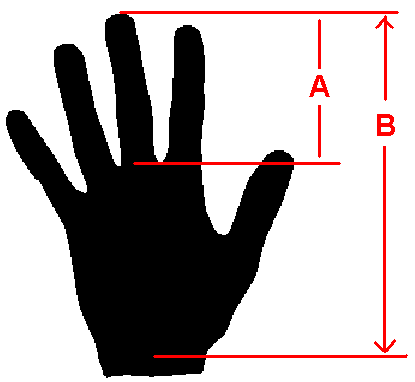
|
GRIP SIZE
What is the length from the end of your middle finger to the "V" bottom between your middle and index finger?.....
"A"
What is the length from the major crease of your inner wrist, when bent, to the end of your middle finger?....."B"
| If "B" is.... | If "A" is... |
| 5.75" - 6.50" minus 1/32" | 2"-3" add 0" |
| 6.50" - 7" minus 1/64" | 3"-4" add +1/64" |
| 7" - 7.75" add 0" | 4" + add +1/32" |
| 7.75" - 8.25" add 1/64" | ... |
| 8.25" - 8.75" add 1/32" | .... |
| 8.75" - 9.25" add 1/16" | .... |
To determine the size of a grip that is on a club...Measuring from the top edge of the grip down to the bottom of the grip.
1" down=A
2" down=B
3" down=C
6" down=D
9" down=E
On a standard grip..A=.950" B=.900" C=.860" D=.780" E=.720"
for +1/64"..add .015" to the above sizes..EXP (C) would be .860"+.015"=.875"
for + 1/32".. add .031" to the above sizes
for +3/64"..add .046" to the above sizes
for +1/16"..add .062" to the above sizes
Going the other way you just subtract the sizes....
When you go to put grips on...You can not just say I need 3 wraps of tape. You must know the inside diameters of the grip and the diameter of the shaft to determine the end size of the installed grip. Grips come with different inner diameters. (They are noted in the golf catalogs.) A 580 (.580" diameter) grip on a 580 shaft (a shaft that measures .580" at the end) will give you a standard grip size...A 600 grip on a 580 shaft will give you 20 thousands under size...ya da, ya da.
The best to get is the .580" (requires less building up). The .580" refers to the core diameter of the grip. Make sure you order the "round" and not the "ribbed" version. Also use 2" masking tape to do the build up.. A 10" piece, length wise will give you an increase of .010" in diameter of the shaft. Once you get the old grip and tape off you need to measure the diameter of the shaft. This is necessary to see how much built up is required to achieve the grip size you wish to end up with. Let's assume the shaft is .600". If you put a .580" core grip on this shaft you end up with a grip size of +.020" oversize. (.600" minus .580"=+.020" you a stretching 580 over 600)... If you want to be +1/32" (.031") oversize put one wrap of 2" masking tape on the shaft which gives you get the diameter of the shaft to .610", now when you put the 580 grip on you will end up at +.030" oversize on the grip (+020" (stretch) +.010" (one wrap 2" tape) equals +.030". DO NOT consider the two sided tape into any of your calculations..it has been factored into the grip by the manufactureres.
Get a roll of 3/4" (not the 2",the strips, water activated, or carpet ) two sided grip tape when you order the grips and a small shaft vice.. It is alot easier to work with. When you have the build up tape on and are ready to put the two sided tape on, start at the lower end (towards the head of the club) (10" from end) and run the tape up and over the shaft end and down the other side. Be sure to cover the end of the shaft. Clamp your club in a vice so the shaft is horizontal to the floor. Put some thing under the two sided tape to catch the Naptha run off when you saturate the tape. Don't get the grip solvent..go down to the local hardware and get a quart of VMP-Naptha. Works as well and is a lot less expensive. I put mine into one of those plastic catsup dispensers you see in resterants. It makes it a lot easier to fill the grip with solvent. Fill a grip with Naptha, holding your finger over the small hole in the end cap of the grip. Hold the grip over the two sided tape, release your finger and allow the Naptha to run all over the tape. Slide the grip on the shaft and push the grip on using the upper end once it has started on the shaft until it bottoms out on the shaft. If you push on the lower part of the grip it will stretch the grip and reduce the grip size.
You have now put on grips that are properly fit to your hands.
Top of Page
Club Loft
Loft is the face angle of golf clubs. It is measured in degrees and progresses
from very shallow in the long irons to very steep in the short irons and wedges. A one iron may be 16 degrees and the sand wedge 56 degrees. The resulting flight of the ball is affected in two ways: distance and height. The shorter irons hit the ball higher with less travel after landing and the longer irons hit the ball lower with more run after landing. More back spin is produced with higher lofted clubs. All clubs should have the loft and lie set prior to assembly to insure consistency. If this angle is not in proper sequence, the distance the ball travels will be adversely affected. Normally, a golfer expects 10 yards difference in distance for each club. There is usually 4 degrees difference between clubs but this is determined by the manufacturer and there is no industry standard for this measurement.
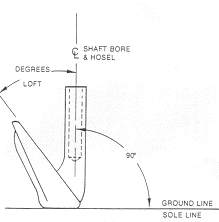
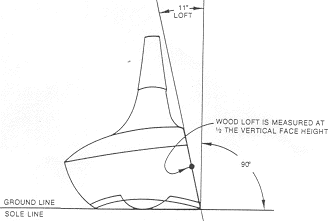
Club Lie
1....The lie angle of the golf club can have a significant impact on ball flight direction.
2....Club length can have a significant effect on the lie of a golf club.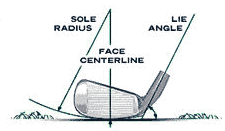
Clubs that are to short cause lie angles that are too flat (heel in the air), the toe of the club will impact the ground first and have a tendency to push the ball to the right.
Clubs that are to long cause lie angles that are too upright (toe in the air), the ball flight will tend to be to the left especially with the more lofted irons.
Although it is possible to hit the ball straight with improper lie clubs, it just means that the golfer has compensated for this by adjusting his swing, aim and/or posture to the clubs lie and as a result their consistency suffers.
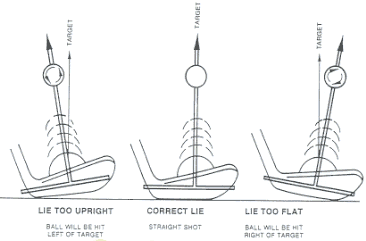
Top of Page
Kick or Bend Point
.... Shaft kick/bend (same thing) points have virtually no effect on ball trajectory. Results from tests on 1000+ golf shafts by Golf Smith showed that there was only 1 degree difference in ball trajectory between
identicle clubs made from the lowest kick/bend point shaft they
found and a club made from the highest kick/bend point
shaft they found. ONLY 1 DEGREE. All of the bend points from these 1000+ shafts fell within a one and one half inch span on the shaft. Chalk up one more for "HYPE"
Top of Page
Shafts A,L,R,S,X ?.
... Shaft flex letters on golf
shafts ie.A,L,R,S,X have little
meaning because there is no standard of
measuring flex with in the golf shaft industry. Each manufacturer has their on particular method to measure the flex of golf shafts.
Results from indepebdent tests done on the same 1000+ shafts by
Golf Smith not only showed that one companies "R" flex
equaled another companies "S" flex and so on, there were even overlapping flexs with in individual companies.
... Golf Smith tested and then rated all these
golf shafts by mile per hour so there is now
a truly accurate method of determining the true flex of shafts for golf club-makers like myself, thus assuring that you are getting the correct flex for your swing.
Top of Page







